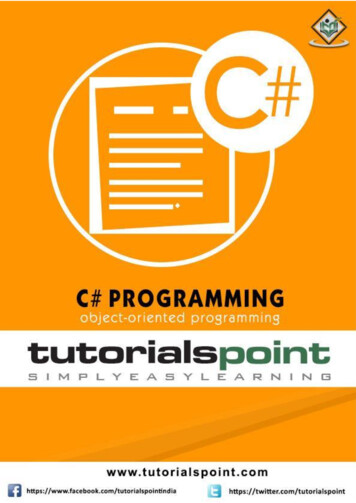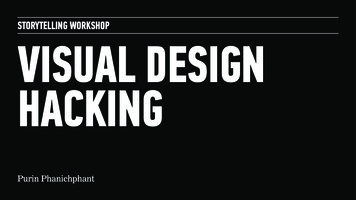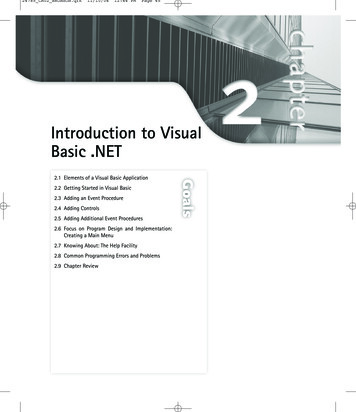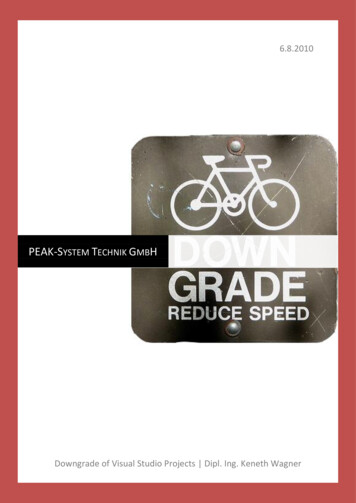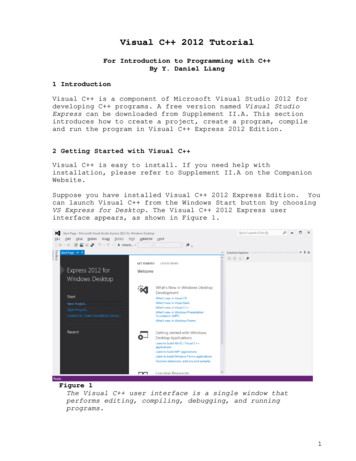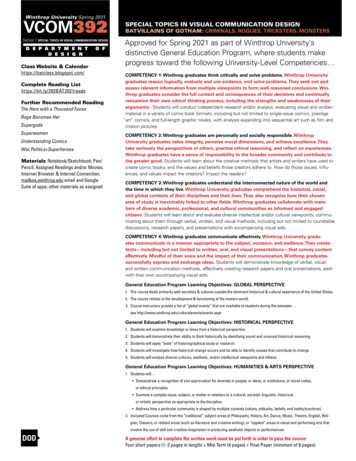
Transcription
Winthrop University Spring 2021VCOM392Section 1special topics in visual communication designD E P A R T M E N TD E S I G NO FClass Website & Calendarhttps://batclass.blogspot.com/Complete Reading Listhttps://bit.ly/392BAT2021readsFurther Recommended ReadingThe Hero with a Thousand FacesRage Becomes HerSupergodsSuperwomenUnderstanding ComicsWar,Politics SuperheroesMaterials Notebook/Sketchbook; Pen/Pencil; Assigned Readings and/or Movies;Internet Browser & Internet Connection;mailbox.winthrop.edu email and GoogleSuite of apps; other materials as assignedSPECIAL TOPICS IN VISUAL COMMUNICATION DESIGNBATVILLAINS OF GOTHAM: CRIMINALS, ROGUES, TRICKSTERS, MONSTERSApproved for Spring 2021 as part of Winthrop University’sdistinctive General Education Program, where students makeprogress toward the following University-Level Competencies COMPETENCY 1: Winthrop graduates think critically and solve problems. Winthrop Universitygraduates reason logically, evaluate and use evidence, and solve problems. They seek out andassess relevant information from multiple viewpoints to form well-reasoned conclusions. Winthrop graduates consider the full context and consequences of their decisions and continuallyreexamine their own critical thinking process, including the strengths and weaknesses of theirarguments. Students will conduct independent research and/or analysis, evaluating visual and writtenmaterial in a variety of comic book formats, including but not limited to single-issue comics, prestige“art” comics, and full-length graphic novels, with analysis expanding into sequential art such as film andmotion pictures.COMPETENCY 2: Winthrop graduates are personally and socially responsible. WinthropUniversity graduates value integrity, perceive moral dimensions, and achieve excellence. Theytake seriously the perspectives of others, practice ethical reasoning, and reflect on experiences.Winthrop graduates have a sense of responsibility to the broader community and contribute tothe greater good. Students will learn about the creative methods that artists and writers have used tocreate comic books, and the values and beliefs those creators adhere to. How do those issues, influences, and values impact the creators? Impact the readers?COMPETENCY 3: Winthrop graduates understand the interconnected nature of the world andthe time in which they live. Winthrop University graduates comprehend the historical, social,and global contexts of their disciplines and their lives. They also recognize how their chosenarea of study is inextricably linked to other fields. Winthrop graduates collaborate with members of diverse academic, professional, and cultural communities as informed and engagedcitizens. Students will learn about and evaluate diverse intellectual and/or cultural viewpoints, communicating about them through verbal, written, and visual methods, including but not limited to roundtablediscussions, research papers, and presentations with accompanying visual aids.COMPETENCY 4: Winthrop graduates communicate effectively. Winthrop University graduates communicate in a manner appropriate to the subject, occasion, and audience. They createtexts—including but not limited to written, oral, and visual presentations—that convey contenteffectively. Mindful of their voice and the impact of their communication, Winthrop graduatessuccessfully express and exchange ideas. Students will demonstrate knowledge of verbal, visual,and written communication methods, effectively creating research papers and oral presentations, eachwith their own accompanying visual aids.General Education Program Learning Objectives: GLOBAL PERSPECTIVE1. The course deals primarily with societies & cultures outside the dominant historical & cultural experience of the United States.2. The course relates to the development & functioning of the modern world.3. Course instructors provide a list of “global events” that are available to students during the semester see General Education Program Learning Objectives: HISTORICAL PERSPECTIVE1. Students will examine knowledge or ideas from a historical perspective.2. Students will demonstrate their ability to think historically by identifying sound and unsound historical reasoning.3. Students will apply “tools” of historiographical study or research.4. Students will investigate how historical change occurs and be able to identify causes that contribute to change.5. Students will analyze diverse cultures, aesthetic, and/or intellectual viewpoints and milieus.General Education Program Learning Objectives: HUMANITIES & ARTS PERSPECTIVE1. Students will Demonstrate a recognition of and appreciation for diversity in people, or ideas, or institutions, or moral codes,or ethical principles. Examine a complex issue, subject, or matter in relations to a cultural, societal, linguistic, historical,or artistic perspective as appropriate to the discipline. Address how a particular community is shaped by multiple contexts (values, attitudes, beliefs, and habits/practices).2. Included Courses come from the “traditional” subject areas of Philosophy, History, Art, Dance, Music, Theatre, English, Religion, Classics, or related areas (such as literature and creative writing), or “applied” areas in visual and performing arts thatinvolve the use of skill and creative imagination in producing aesthetic objects or performances.A genuine effort to complete the written work must be put forth in order to pass the course:Four short papers (1–2 pages in length) Mid-Term (4 pages) Final Paper (minimum of 8 pages).
Winthrop University Spring 2021VCOM392Section 1special topics in visual communication designD E P A R T M E N TD E S I G NPrerequisite(s)Credit HoursLecture HoursLab HoursOther HoursContact HoursLevelMeetingsO FNONE*30062.5 hours/weekUndergraduate(3:0:6) Section 001M/W 11 am –12:15 pmONLINEWingspan 21176Lab Fee 0Exam Writing DeadlineFINAL PaperDUE April 29*VCOM/DESF300 pre-req waved for Spring 2021.Jason Tselentis ProfessorWinthrop UniversityCollege of Visual and Performing ArtsDepartment of DesignOffice: 240 McLaurin HallOffice Hours: M–Th 1:30–2:30 p.m.Other Availability by AppointmentPhone: 803-323-4565tselentisj@winthrop.eduSPECIAL TOPICS IN VISUAL COMMUNICATION DESIGNBATVILLAINS OF GOTHAM: CRIMINALS, ROGUES, TRICKSTERS, MONSTERSCourse Description Extended individual opportunities in communication designstudy beyond existing program curriculum.Course Goals1. Understand the visual language of comic books, and how to read them.2. Identify themes found in Batman, Batgirl, Batwoman comic books & graphic novels.3. Analyze the cultural, societal, economic, and political issues found therein.4. Examine how history influences comic creation.5. Assess issues & influences through writings, discussions, presentations.Student Learning Outcomes By the end of this course, students should beable to: Understand the visual language of comic books. Recognize how comic bookcreators, bring stories to life. Identify themes and genres found in comic books, andthe ways art and writing influence them. Think critically about comic books & graphicnovels. Communicate effectively about comic books & graphic novels.Class Content Failure to complete coursework may result in failure of the courseand/or a grade that would prolong (or prevent) students from earning their degree(s).Lectures/Briefings. The instructor will deliver lectures each week, up to twice per week,giving background about the week’s content.Group Discussions, Group Work, Writing Work, and Participation. Studentparticipation and in-class work may include the completion of in-class writingassignments, leading or participating in group discussions, critiquing a comic bookor graphic novel, or preparing for an upcoming assignment. In some cases, yourcontribution to your own work or your peers’ work could factor into your own grade.Teamwork and group work will factor into each student’s individual grade.Outside of classes, students will read assigned books and listen to podcasts. In additionto learning about comic books & graphic novels through historical and cultural lenses,students will learn about the ways that art and drawing and illustration have influencedtheir creation, and the ways comic books have influenced design and popular media.Students will develop and understanding of narrative, aesthetics, genre, technology, andhistory over the course of the semester. Movies may be viewed in class or out of class toaugment our assigned readings.Assigned Content. Students are required to read assigned content, and at times, may berequired to view film content or listen to radio or podcast content. Graphic and/or adultthemes, images, content, and language will be presented at times. Such content—as wellas all content in this class—will be viewed critically, with students and faculty discussingthe artistic and literary merits, including but not limited to the intentions of the artist(s),writer(s), producer(s), and publisher(s), and the way the comic books & graphic novelsrelate to history, culture, and the art and/or design world(s), and how they impact visualculture at large. Global cultures will be investigated, beginning with early 20th Centuryimmigration to the United States and the impact that identity and identity politics had onmetropolitan communities, social constructs, and urban/suburban sprawl. We will researchthe devastation of World War II, the Holocaust, and the cultural divides it created.Course Requirements See Evaluation/Assessment Criteria for more information.Students are expected to attend all classes for the semester; five (5) documentedabsences will mean automatic failure regardless of the final letter grade you earnedfor the term. Complete work as assigned. Participation during meeting times shallinclude research, discussion, taking notes, and/or reading or viewing comics eitherindependently or with a group. Out-of-class research may include visits to the library,Winthrop Writing Center, or other resources as assigned. Out-of-class research mayalso include field work, requiring students to collect data or conduct interviews.Assigned work may have a number of deadlines, as posted on the class calendar,viewable at the class website. Deadlines must be met. No late work will be accepted.Up to 200 points may be earned towards class participation, with discussions, groupactivities, worksheets, an occasional open-note quiz, and also work done online.Four short writing assignments shall be assigned. The out-of-class Mid-Term projectconsists of at least 4-pages of written content. The Final writing assignment shall be atleast 8 pages of written content.rev. 01 10 2021 @ 10:301
Winthrop University Spring 2021VCOM392Section 1special topics in visual communication designD E P A R T M E N TD E S I G NO FCalculating Your Final Grade20010080120500Weekly Class ParticipationGroup Reports, 4 worth 25 pts.Mid-Term PaperFinal PaperTotal PointsSee the final pages of this syllabus forgrade sheet and rubric samples, andan example of how your final gradewill be calculated for the semester.Confidentiality of ContentWith the availability of hardware and softwareenabling audio and video capturing of material,lectures, courses, etc.—and the use of socialmedia—it is essential to be mindful of thefollowing policies and considerations: Faculty andstudents need a safe space in which to discusstopics that can be difficult due to differingClass Calendar & Content (Subject to Change)See full Winthrop calendar at www.winthrop.edu/calendars/ online.Jan. 11First day of classesJan. 11–15 Registration continues via Wingspan, Add/Drop periodJan. 18Dr. Martin Luther King, Jr. Holiday, NO CLASSES, Winthrop CLOSEDFeb. 16Spring Break day 1, NO CLASSES, offices openFeb. 25Interim grades, progress reports shared with all studentsMar. 1Submissions due to SOURCE Undergraduate Research h/news-and-events.aspxMar. 3Spring Break day 2, NO CLASSES, offices openMar. 18Spring Break day 3, NO CLASSES, offices openMar. 24Advising Season BeginsApr. 9Spring Break day 4, NO CLASSES, offices openApr. 16SOURCE Undergraduate Research Symposium PresentationsApr. 19Spring Break day 5, NO CLASSES, offices openApr. 23Friday, last class meeting for SpringApr. 27Tuesday, Study DayApril 29 Final Research Paper DeadlineMay 6May 7May 10ALL SENIOR grades dueALL grades dueALL grades available on WingspanCoursework & Topics (Subject to Change)Work may be assigned during class or for doing outside of class.Gotham, a Primerexperiences and points of view. Students andThe Golden Age of Batman, Bob Kane & Bill Finger, Detective Comicsfaculty must agree that course discussions inGangsters, criminals, political and cultural impacts, and the anti-heroany format are safe from the fear of being postedor shared with individuals outside of the courseCharacter development, leadership, villainssection. No recordings of any format (audioBruce Wayne as orphan, and Gotham’s crime scene full of “the others”and/or video) may be captured without directThe crime scene, detective and pulp stories, what is “pulp fiction”permission from the instructor. Recordings, eventhose approved by the instructor, may not beposted to any internet hosted location, copied/duplicated, or shared with others. Any approvedThe Silver Age & Bronze Age, the Modern AgeBatman as detective, hero, vigilante, the vengeful Dark Knightrecording is to be used as a learning resourceTricksters, the Jokeronly by the students in the specific section. AtBatman, 1989 moviethe end of the semester, any and all personalcopies of recordings must be destroyed (deletedand removed from trash) from either university-Batman the Animated SeriesThe psychology of Batman and Batvillainsprovided storage resources or student-ownedThe Wrath, the Red Hoodstorage devices. Faculty should notify studentsBatman in a post-Comic-Code landscapeprior to recording any in person or online classsessions, and allow students to disable videofeed if desired.Batman Movies, Toys, Merchandise, the “Toyetic”Health & Wellness, the cost of heroism and heroicsTeams and teamwork, Justice League to Batman & The OutsidersFamily TiesViolence and ultra-violenceGods, Monsters, and Villains, the Rogue’s GalleryBatgirl, Batwoman, RobinBeyond BatmanBatman as brand, as company, as incorporated organization“Alt” Worlds, Gotham in the past, present, and futureThe Batman Who LaughsBatman across media, television to moviesTelevision and movies, casting actors in roles and cultural representationLife, death, and the hereafter the future of Batvillains2
Winthrop University Spring 2021VCOM392Section 1special topics in visual communication designD E P A R T M E N TD E S I G NSemester at a Glance (Subject to Change): This week-by-week timetableprovides a look at what we can expect during the semester. Monitor theclass website and calendar for the most up-to-date schedule.O FThis syllabus is complete and accurate at theJan.time of distribution. At times a change will benecessitated to the syllabus content, policies,project calendar or other information. When thishappens the class will be notified both in classWeek 2Batman, a primerGangsters, criminals, political and cultural impactsThe Golden Age of Batman, Bob Kane & Bill FingerBruce Wayne as orphan, Gotham’s crime sceneCharacter development, leaders vs villainsand via e-mail of the change to the syllabus,and presented with corrected information as itWeek 1Week 3Detective and pulp stories, what is “pulp fiction”becomes available. The student has received,Hero, vigilante, entertainer, Playboyread, understands, and agrees to be bound byThe “fun” Batman (1966) compared to the Dark Knightthe stated course requirements and objectives asoutlined in the syllabus provided by the instructor.They understand that failure to follow theregulations may affect their final grade, up to andincluding graduation requirements.Feb.Week 4Prestige comics and comic book editions, the graphic novelTricksters, the Joker, Batman 1966 & Batman 1989 movieBatman the Animated SeriesWeek 5The psychology of Batman, and BatvillainsWeek 6The Wrath, the Red HoodMar.Week 7Teams & teamwork, Justice League, The OutsidersWeek 8Batman in a post-Comic-Code landscapeCasting actors in roles and cultural representationWeek 9DUE Mid-Term PaperWeek 10Violence and ultra-violenceApr.Health & Wellness, the high price of heroicsGods & MonstersWeek 11Villains, the Rogue’s GalleryWeek 12Batgirl, Batwoman, RobinWeek 13Batman as brand, as companyWeek 14Gotham in the past, present, and futureThe Batman Who LaughsWeek 15The future of Gotham, television and moviesWeek 16Last Class MeetingLife, death, and the hereafter the future of BatvillainsApr. 29DUE Final Research Paper3
AttendanceCLASS POLICIESThe instructor will take attendance at every meeting. Five (5) documented absences willmean automatic failure regardless of the final letter grade you earned for the term. Thereis no distinction between “excused” and “unexcused” absence. A student who arrives toclass unable to execute studio work due to lack of necessary materials, will be unable toparticipate in class that day. As a result, such a situation will be regarded as an absence. Aproject is late (has missed the deadline) when it is not turned in by the date/time directed.No late projects will be accepted, regardless of reason. It is critical that you attend classbecause a majority of our course content is only covered during our scheduled meetingtimes. If a class is missed, it is the responsibility of the student to obtain any missedmaterial or information.Materials/TextbookStudents are expected to acquire and be responsible for all materials and textbooksindicated on the syllabus. The materials specified on the list are specific to this class, andhave been reviewed with a mind toward what is required to successfully complete theprojects. A textbook listed as “required” for the class is exactly that. Students are expectedto arrive for every class prepared with appropriate materials (including homework,projects, research and production supplies) needed to make the most productive use ofthat day.Evaluation / Assessment CriteriaClass activities consist of major projects and additional exercises and activities, each withtheir own point value. The instructor assesses your work done in class and outside of class,using a variety of criteria, including:Meeting Project Requirements (including deadlines): includes adherence to size/ color/format/ and other limitations imposed by the project. No late projects will be accepted. Tothe end that being “late” on a project can be anticipated, the student is expected to devisea solution to submit the project, complete, and by the deadline. There will be in-class work,where you will be expected to meet a deadline that occurs during the scheduled meetings;there may also be deadlines at the start of class, where you are expected to have workprepared to review promptly at the beginning of the scheduled meeting time. Reworkingprojects is at the discretion of the instructor, but reworking of a project is, in itself, noguarantee that a better grade will resultDevelopmental Process: how the student has researched, experimented, explored,executed, and expanded on the problem the instructor has presented; the amount andquality of background research (conceptual, environmental, visual, historical, etc.) thestudent puts into the solution (this metric does not assess student improvement(s) overthe course of the semester).Presentation and Craft: professionalism depends on technical precision and exactitude;“effort” and “intention” on a project does not supplant results. Craft and presentation willbe very closely scrutinized, and unacceptable craft will substantially impact the final grade.Composition: organization of visual information, application and use of media, and othervisual qualities relating to the finished design; projects can be well-researched, craftedprofessionally, and show evidence of a concept while still not being compositionallyunified, visually interesting, dynamic and/or effective.Concept: effectiveness of the project solution, and how well the student has provideda distinctive interpretation; how well the concept has been defined and applied; theappropriateness of the concept, its unique and the overall relevance to the problempresented.Each project the student completes will be returned to them with an accompanying“rubric” that will describe the components used to evaluate that project; this rubric willdescribe the student’s result of evaluation (grade), and include comments that will help thestudent to determine areas of strength or in need of development for the project.rev. 1/214
Grade Scale (VCOM foundation-sequence; project totals)A 96.0 and aboveA- 92.0 – 95.9B 88.0 – 91.9B 84.0 – 87.9B- 80.0 – 83.9C 76.0 – 79.9CLASS POLICIESYou must make a C or better in all of your required courses in order to be eligible for theSpecialization Review in the Department of Design.C 72.0 – 75.9C- 68.0 – 71.9D 64.0 – 67.9D 60.0 – 63.9D- 56.0 – 59.9F 55.9 or belowIncomplete Grades: A final grade of “incomplete” is generally not considered, with theexception of extraordinary circumstances (e.g. an extended illness, et. al.), and must behandled with the instructor of a class, and approved by the Chair of the Department, noless than two weeks prior to the end of the semester, or handled through the office of theDean of Students.Class Instructional Methods / How We WorkStudio Time (Lab): There will be time in class to work; you will also be required to workoutside of class in your personal studio space. Come to class prepared and ready to workeach day. Bring all materials, tools, research data and work in progress to class. Studentsare responsible for all information and handouts during the course of the semester.If anything unique will be required it will be announced in advance. Use class timeeffectively. When a project is due it must be completed before class for a group critique.Class time should not be used for retrieving appropriate materials, nor should class timebe used for work pertaining to other classes, design-related or not. If the instructor feelsthe student is using the time inappropriately, or is unprepared, the student may be askedto leave the class and be recorded as absent.Lectures: Delivery of historical background, project descriptions, project backgrounds,design methods, and demonstrations to prepare students for projects. Students may needto take notes or otherwise document important content that is delivered in lectures as itmay be needed during the production of a project, or otherwise asked for on a test.Projects/exercises: Students will complete projects based on communication goals,context, visual research, and critique feedback. Projects will be executed through appliedhand and photo-mechanical skills. You will learn about controlling and rendering withtraditional and computer media, conducting research & analysis, and creating visualprototypes & final designs. Handouts, independent research, design exploration & studies,technical development, and experimentation will guide your process. The craft quality willbe closely scrutinized. Project solutions must follow the assigned directions appropriately.All projects are expected to adhere to the presentation size(s) stated on the project sheets.All projects handed in should include a tracing paper overlay unless otherwise statedin the project brief. Variance from requirements will lower your grade for that project,and can greatly impact your final grade for the semester. A project is late (has missedthe deadline) when it is not turned in by the date/time directed. No late projects will beaccepted, regardless of reason.Critiques : These assess your work in progress and/or final work by giving youconstructive advice for developing craft, composition, and concept. These critiqueswill be a major component of this class, your design curriculum at Winthrop, and yourprofessional career after the university. You will learn how to present and defend yourwork before an audience of the class. You will also learn how to receive constructivecriticism and deliver it yourself. Full, candid and constructive participation is expected.Learn to take advantage of your colleagues’ input because you have the opportunity tolearn from others’ mistakes, dilemmas, and successes.Homework: There will be projects assigned as homework that will take place out of class.Be prepared to spend as much time as is necessary to finish your work. Be prepared todevote (minimally) 2-2.5 hours per week outside of class for every credit hour.rev. 1/215
RVRC, Production & Support Material! Note: Availability may be impacted by COVID-19CLASS POLICIESStudents have access to the Rutledge Visual Resource Center (RVRC) during its posted,open hours. RVRC holds various equipment (photocopiers, light tables, and otherequipment) that is useful in the production of final projects. All users must adhere tothe policies for use of RVRC and its equipment. As with any technological facility, RVRCoccasionally experiences breakdowns or the need for equipment cleaning or repair.Students are reminded that “there are other photocopiers in the world;” RVRC capabilitiesrepresent a convenient asset for students, but lack of access or unexpected equipmentbreakdown does not relieve the student either of the project deadline or expectation ofquality or completeness for a project.RVRC also holds computing and related equipment, as well as the student data server“Turnstile2”. Design students may be permitted to use this equipment, depending oncourse level, project requirements, and instructor policies. Turnstile2 (T2) is an openaccess, unsecured data server that - essentially anyone - can read/write to; users savedata to it at their own risk. Use of computers and storage of data is expected to adhereto appropriate use guidelines, published by the university. Students are encouraged tosave their files responsibly on their own media, such as USB (”flash”) key, cloud storage(DropBox, GoogleDrive, etc.), or external hard drive; relying solely on one storage mediais not recommended. To access T2 remotely from on-campus:IP Address 10.2.64.60 Sharepoint (PCs) turnstile2 Click “Guest” Radio Button/ Option.Misc. PoliciesClass Cancellations: The instructor will attempt to notify the students in advance bye-mail if there is a cancellation. Otherwise cancellations will be handled only throughthe Department of Design (DoD) office., or (in the case of extreme weather or otheremergencies) is handled by the university. Barring notification by one of these “official”sources, students are expected to be present and productive for every scheduled classmeeting regardless of whether or not the instructor is actually present.E-mail / Distribution Lists: at the beginning of the semester students are automaticallyadded to the distribution list for a class. In certain situations (late registration) a studentmay be omitted from the distribution list. To manually subscribe to the distribution list fora course, send an e-mail to consult the following list-server.aspxE-mail is considered an official method for communication at Winthrop University.Students must activate and maintain a valid Winthrop e-mail account and check itto stay apprised of class developments, instructor or coordinator announcements,class cancellations, weather-related emergencies, advising times, and reviews. NonWinthrop e-mail contacts will not be used. Students are responsible for any informationcommunicated to them via the Winthrop e-mail account. Failure to check the e-mailaccount (including “spam” depots) do not abrogate the student from responsibility forthe content of the e-mail. Campus guidelines on the appropriate use of e-mail and theuniversity technology policy can be learned about lization Review: Class grades include a variety of criteria beyond the gradesachieved on individual projects. A minimum final grade of “C ” is required in all VCOMcourses required for your program in order to take the review (This means: a “C ”qualifies you to take the SPR but a “C” does not.) However, it should not be construedthat acceptable grades in classes assures passage of the Specialization Review. TheSpecialization Review is a practice of reviewing the body of work done in all VCD-relatedclasses numbered below DESF300, and is intended to determine whether or not the workevidences mastery of the skills and concepts which are needed for upper division study.Further details and specifics relating to the Specialization Review are available through theDepartment of Design office, and at various meetings which are held several times eachyear concerning the review. For specific questions or details, the students is referred tothese resources, and is encouraged to consult their academic advisor.rev. 1/216
Usage of Student Work: By enrolling in and participating in this program and/or course(s)and its activities, the student grants to the Department of Design and its faculty the rightto reproduce in part or in whole in any size and in any media the work(s) created for VisualCommunication Design (VCOM) and/or Interior Design (INDS). For complete explanationand details of this reservation, please consult the latest revision of the Dept. of DesignStudent Handbook.CLASS POLICIESMobile Devices: must be set to vibrate during class; do not use these items during classunless you have permission, else you risk dismissal from class and will be countedabsent. Any disruption to the classroom environment caused by these devices may resultin the student being asked to leave, and cou
Writing Deadline FINAL Paper DUE April 29 SPECIAL TOPICS IN VISUAL COMMUNICATION DESIGN BATVILLAINS OF GOTHAM: CRIMINALS, ROGUES, TRICKSTERS, MONSTERS Course Description Extended individual opportunities in communication design study beyond existing program curriculum. Course




